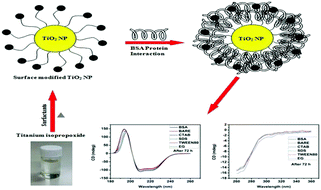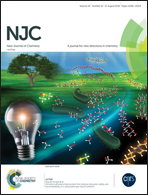Synthesis of bare and surface modified TiO2 nanoparticles via a single source precursor and insights into their interactions with serum albumin†
Abstract
This work reports the synthesis of bare and surface modified titanium dioxide nanoparticles (TiO2 NPs) via solvothermal decomposition using titanium isopropoxide as the single source precursor (SSP). The nanoparticles were then subsequently characterized by UV-Visible (UV-Vis) spectroscopy, Fourier Transform Infrared (FTIR) spectroscopy, powder X-ray diffraction (PXRD), X-ray photoelectron spectroscopy (XPS) and transmission electron microscopy (TEM) techniques. The interactions of the as-synthesized nanoparticles with bovine serum albumin (BSA) at room temperature were studied by using various spectroscopy techniques such as fluorescence spectroscopy, dynamic light scattering (DLS) analysis and circular dichroism (CD). The spectroscopic investigation sheds light into various aspects of binding during the molecular association of BSA with the nanoparticles. Minor local conformational changes are observed in the protein structure in the presence of the nanoparticles however the tertiary structure remains intact even after 72 h. The TiO2 NP–BSA system was found to be the most stable in the presence of nonionic surfactant. This study provides valuable mechanistic insights into the interactions taking place at the interface of the nanoparticles, which can further help in choosing the ideal surface modifier for designing better biocompatible NP systems.



 Please wait while we load your content...
Please wait while we load your content...